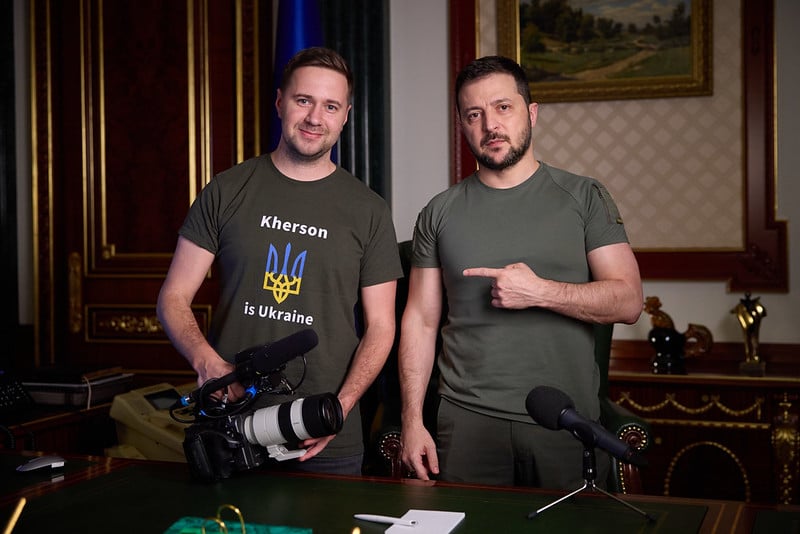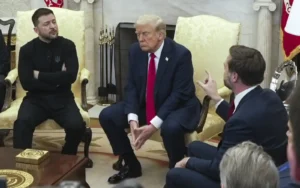Statement by President Volodymyr Zelenskyy after liberation of Kherson, 11 November 2022 (Flickr)
After Russia’s Defense Minister Sergei Shoigu ordered its troops to withdraw from Kherson, Ukrainian forces recaptured the city on November 11. Any Russian troops that remain in the city were ordered to surrender. The return of Kherson in Ukrainian hands means a humiliation for Russia – it lost the only regional capital it captured since the start of the invasion. the first signs of the atrocities that local residents endured during the Russian occupation are becoming visible. After this new blow for Russia’s ambitions in Ukraine, many look for what will happen now as Ukraine carries the momentum in the ongoing war.
Ukrainian soldiers received as heroes after Russian withdrawal
A swift Russian departure made room for the Ukrainian army to retake the city without any fight. It led to joy in Kherson, where the soldiers were welcomed as heroes. Crowds of people with Ukrainian flags around their shoulders took to the streets en masse to celebrate their liberation. Meanwhile, the Ukrainian army command called on all Russian soldiers and collaborators in Kherson to surrender. In turn, the Russian army command called on its soldiers who could not retreat to strip and hide in military clothing.
On the day Shoigu announced the withdrawal of its troops, Maria Zakharova, Russia’s spokesperson for the Foreign Ministry, indicated that Moscow was open to negotiations with Kiev – which was immediately rejected by Ukrainian authorities. It appears to be a frantic attempt to buy time in Russia’s political disarray. The costs of the war in Ukraine have been massive for the Kremlin, while the results achieved on the battlefield are diminishing by the week. It remains to be seen how the capricious Russian leadership acts vis-à-vis Ukraine. For now, as winter falls in Ukraine, options seem very limited.
More atrocities in Kherson become visible after Russian retreat
In the run-up to liberation, the Russians first wanted to “evacuate” a large number of the city’s residents – also described by locals as a disguised attempt to deport Kherson’s residents to Russian-occupied areas. It was already clear at the time that the situation in the city was very worrying and according to Roman Holovnya, the adviser of Kherson’s mayor, the situation in the city is “a humanitarian catastrophe”. Residents of the city are lacking basic needs such as water, food and medicine.
Ukrainian President Volodymyr Zelenskyy said on November in 13 in his nightly video address that investigators uncovered and documented more than 400 Russian war crimes in areas of the freed Khersion region. Meanwhile, many residents have disappeared from the city. In villages previously home to a thousand people, like Blahodatne, only sixty remain. Residents told their stories to journalists about torture and deportations that took place in the town and how the Russians took away anything valuable, such as bronze statues or valuable electric equipment.
What is next?
According to Zelenskyy, the recapture of Kherson is the “beginning of the end of the war”. Ukrainian forces must first stabilise the situation and strengthen crucial infrastructure in the city, which was badly damaged under Russian occupation. However, Ukraine is well positioned now that Kherson is back in control, and military analysts see advantages for Ukraine to push the front line further away from the Dnipro river to the east before winter sets in. By stabilising Kherson, Ukraine can simultaneously concentrate on other parts of the 1,000-km-long frontline. Bakhmut would be one of the regions where the Ukrainians could install reinforcements to force a breakthrough in the Donbas, a place where Russian forces have been trying to push through for months without success.
The harsh Ukrainian winter is expected to freeze the front lines, but this is a point of contention among military analysts. Russian troops are poorly equipped and could disproportionately damage their operations compared to well-supplied Ukrainian forces. Therefore, Russian troops are unlikely to be able to halt Ukrainian counter-offensives. Especially as Ukraine will receive more financial and military aid in the coming weeks, their winter advantage over Russian forces is expected to increase. Meanwhile, morale within the Russian army seems to be hitting a new low with each new day on the front.
Meanwhile, Russia is preparing for the counter-offensive. The Russian-occupied Crimea peninsula announced security measures following the Russian withdrawal from Kherson, fearing an advance into the region as the front lines move in its direction. Russian forces are likely to position themselves defensively on the eastern side of the Dnipro River, with new trenches and the possibility of heavily shelling Ukrainian towns and infrastructure. Similar Russian-made trenches, narrow and muddy, have been found near Kherson, symbolising the poor conditions in which Russian troops are positioned by their army command. So at the military level, the initiative now lies on the Ukrainian side, which, since the successes in Luhansk and Kherson, has several options for keeping up the momentum.
Author: Mathieu Neelen
Sources: AlJazeera, FinancialTimes, NewYorkTimes, NOS1, NOS2, NOS3, NU.NL, Politico, Reuters
Photo: Flickr



